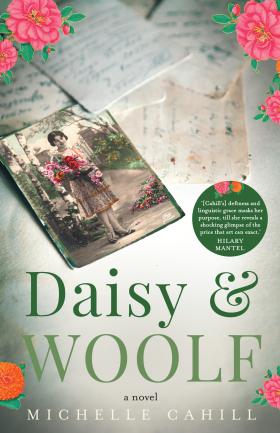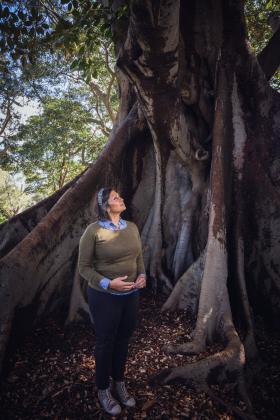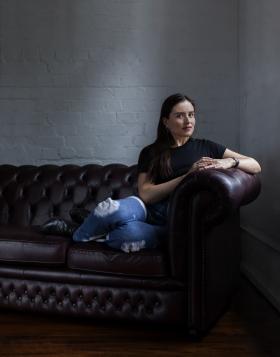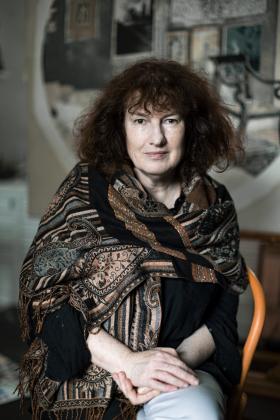Michelle Cahill believes that a letter isn’t just a form of correspondence, a line of communication that joins one person to another. If you’re a migrant, she says, it can be freighted with longing. It can symbolise the gap between dreams and reality. Or it can reflect a desire to connect. During a stint in London, the acclaimed Goan-Anglo-Indian writer and poet sent an email to fellow poet Judith Beveridge.
‘I think I wrote something like: I’ve come back to the centre but I’m still on the periphery,’ she says. ‘Often, there is aspiration, which is the position of the migrant. They are writing an email or a job application to another country, to a fellowship or residency.’
She pauses, a beat between her precise and elegant sentences.
‘There is a sense of anticipation and apprehension about what that will be and where the journey will take them.’
When Cahill and I meet on a stormy Sydney Thursday, our conversation turns often to the power of words. Their magic is reflected in our surroundings. We’re speaking over chai lattes in the courtyard of Glebe’s Sappho Books. Inside, shelves heave with rare volumes. Around us, young women nurse bohemian fantasies, scribbling obsessively in Moleskine notebooks.

In Daisy and Woolf, Cahill’s powerful new novel, which was published in Australia in May and will be released in the United Kingdom in November, a character called Mina surrenders wholeheartedly to the life of a writer. Her mother has passed away and she’s torn between artistic ambition and family obligation. She travels to London, to Lewes and then to Wuhan, where she gives a paper at a conference. She searches for traces of Shuhua Ling, a Chinese modernist writer and artist who was born in 1900 and whose memoir Ancient Melodies was published by Hogarth Press — founded by Leonard Woolf and Virginia Woolf — in 1953.
‘I think that the reader can see that I’m not her even though there’s so much of me in her,’ Cahill says of Mina. ‘She has her own trajectory in [readers’] minds.’
The driving force of Mina’s life is Daisy Simmons, a character who appears briefly in Virginia Woolf’s 1925 novel Mrs Dalloway. Daisy is an Anglo-Indian woman and the married lover of Clarissa Dalloway’s old suitor Peter Walsh, who has arrived in London after five years in India. She’s sketched in the barest of strokes, described as ‘dark’ and ‘adorably pretty’.
‘I was reading Mrs Dalloway and came across a description where Peter is walking through London,’ she recalls. ‘An Anglo-Indian story within such a canonical text in English literature isn’t common. It dawned on me that this was what I had been waiting for.’
In Daisy and Woolf, Daisy, who is also the subject of Mina’s novel-in-progress, wrests back the terms of her representation. She speaks to the reader in letters and diaries. Cahill constructs her inner life — that obsession of modernists everywhere — and renders it on the page, sparkling and fully formed.
Cahill was born in Kenya in 1964. As a child, she migrated with her family to London where she attended primary school. She walked around Holborn, she tells me, thinking about Dickens, imagining his characters.
‘I was aware of a voice — I remember growing up in London and having this sense of history, of stories of the past,’ she says. ‘I remember feeling that I was in my own story but also outside of it.’
Migration can be a source of psychic and geographic rupture. Cahill tells me that it put pressure on her family, who are part of the Anglo-Indian diaspora. ‘We went through tough times financially,’ she says.
After India achieved independence in 1947, it was common for the Anglo-Indian population, citizens of mixed Indian and British descent, to move overseas. The community, already a minority, was further fragmented politically and socially. When Cahill’s family relocated, again, to Sydney in 1975 it represented a second kind of splintering.
‘I felt that in-betweenness all the time,’ she says. ‘It silences you, you are awkward — if you are with the majority of Indians in Australia, you can talk about ethnicity in a much more direct way. My family was reduced by generational migration. I was relying on bits that I picked up. I was limited by those things because I couldn’t draw from an entire community and I wanted to be able to.’
As a teenager, reading was a salve. At first, the classics: Thomas Hardy, DH Lawrence, the Brontës and George Eliot. Cahill learned about syntax and style — the architecture of a good sentence — by rereading Jane Austen. At the University of Sydney, where she studied arts and medicine, she started to think of Austen — she writes to me, laughingly, over email — as ‘glorified Mills & Boon’. At university, Cahill,who speaks warmly about her parallel career as a general practitioner, was exposed to activist thinking. What could it mean to write ethically? Her tastes shifted toward Margaret Atwood, Tsitsi Dangarembga, Ngũgĩ wa Thiong’o, Milan Kundera, Albert Camus, Doris Lessing.
‘[When] I was reading as a young writer,’ she says, ‘I started realising that a lot of my work would be about how to bring that minority narrative into the mainstream.’
Cahill published her first collection of poems, The Accidental Cage, in 2006. In 2017, she won the Glenda Adams Award for New Writing at the NSW Premier’s Literary Awards for Letter to Pessoa, which was also longlisted for the ASL Gold Medal and shortlisted in the Steele Rudd Award.
Pessoa, a Portuguese poet, wrote under 72 heteronyms. The work, Cahill’s first collection of short fiction, played with ideas of personae. It took the form of letters addressed to literary greats — like Jacques Derrida, Jean Genet and Vladimir Nabokov. Her ‘Letter to John Coetzee’, a writer known for working in the space between fiction and nonfiction, is written by Melanie Isaacs, a minor character in Coetzee’s 1999 novel Disgrace.
Vishvarūpa, a poetry collection originally released in 2011 by Five Islands Press and reissued in 2019 by UWA Publishing, was also formally inventive. What could multiplicity sound like? How can a writer speak many voices? Vishvarūpa, in Sanksrit, means to have many forms. One of the poems I like best, ‘Kali from Abroad’, begins: ‘Kali, you are a poster-goddess/sticking out your black tongue/like Gene Simmons from KISS’. In its accretion of gem-like details and confluence of the mythic and the everyday, it reminds me most of bricolage.
Cahill says that The Bhaghavad Gita, the sacred Hindu text, has been formative for many Western poets.
‘People like Christopher Isherwood and TS Eliot have references to Indian mythology,’ says Cahill, who also won the 2014 Hilary Mantel International Short Story Prize. ‘To think about where the goddesses came from is a way of looking at literary traditions from my own perspective.’ She stops for a moment. ‘In Hinduism, there are many gods but there is one Brahma — so I felt like it was a way to complicate the idea of oneness. I was able to ask questions about my identity as someone who has been colonised — who is also a woman.’
The epigraph of Daisy and Woolf, taken from Virginia Woolf’s 1929 essay A Room of One’s Own, reads: A woman writing thinks back through her mothers. I confess to Cahill that, as much as I admire her, I sometimes think of Virginia Woolf as a sacred cow of white feminism. Lofty. Untouchable. Cahill agrees. ‘She is a formidable thinker,’ she says. ‘[But] I remember reading her work and not at all liking its elitism. In A Room of One’s Own, the history of women writers is restricted to English women; there’s one Anglo-Dutch writer mentioned, Aphra Benn. The exclusion of non-white women from the essay points to a persisting violence in Woolf’s legacy.’
Mrs Dalloway, which uses stream of consciousness to recreate its characters’ subjectivity, is widely regarded a modernist masterpiece. For Cahill, it’s also a novel about empire. She developed Daisy and Woolf, she says, as part of a doctorate at the University of Wollongong, where she received a research scholarship. She read Woolf’s letters and consulted her manuscripts at the British Library.
‘Woolf had these Indian connections,’ says Cahill, who in Daisy and Woolf alludes to the writer’s great-great-grandfather Chevalier Pierre Ambrose Antoine de L’Etang, who ‘fled the guillotine to become a horse trainer in Pondicherry’.
‘Mrs Dalloway is also a novel about imperialism in which India plays an important role. I felt a lot of anger about the way Woolf treats Daisy, but also how she treats India — it is there to make the British aristocracy seem impressive and powerful and civilised — and civilising.’
Cahill, through Daisy’s eyes, vividly evokes life as a mixed-race woman in colonial India. Daisy writes to Peter from Garden Reach, Calcutta, in 1924. She describes protest on the streets, ‘broken-spirited soldiers’ returning from war, attacks by the local Brahmin boys. She leaves her unhappy marriage to be reunited, in London, with Peter. She voyages on a ship, through Ceylon (Sri Lanka), the Gulf of Aden and Malta, each place reshaping her inner world. Her journey is echoed, nearly a century later, by Mina who grapples with the tension between art and maternal duty, the indignities of freelancing, the crises of our moment: Trump, climate change, the cruelties reserved for refugees, migrants, and those who are rootless and itinerant.
Cahill’s family, like many members of the Anglo-Indian community, were historically involved in transport. ‘There’s the idea of people coming to the centre with their bags and suitcases,’ she says. ‘I gave Daisy an interior journey of her own — I love that she is a voyager, or passenger. I think she changes, she goes through transformations as a character.’
The epistolary form is significant. Cahill talks passionately about the value of the paratext — letters, emails, diary entries — that testify to the lives of women who aren’t published, who aren’t always afforded cultural space.
‘I wanted to give Daisy a voice, I wanted her to speak,’ says Cahill. ‘Initially, the novel was all of Daisy’s story followed by all of Mina’s. Cahill’s editors suggested the integration. ‘I like to challenge conventional structures of narrative because they represent a unity and a stability that does not reflect my story whatsoever.’
Daisy and Woolf, a novel about the writing of a novel, can perhaps be read as metafiction. It’s a story about how stories are told and whose lives are erased in the process, about how the cultural forces that extol certain figures, without criticism, can easily relegate others to a footnote.
‘Every mention of Daisy is “dark” and in 100 years of literary criticism there’s been no discussion of that,’ Cahill says. ‘I read one paper that was published in 2014 that [refers to] Daisy as the Englishwoman Peter Walsh plans to marry. How can that be commensurate with the way Woolf describes her?’
Writers of colour, I point out, aren’t necessarily rewarded for taking artistic risks. Often, they are confined to memoir.
‘There’ve been so many attempts to push Daisy back,’ she says. ‘It’s about [preserving] the dialogue between white feminism and modernism, white feminism and experimentalism. I don’t come from a majority community. The pressure is on us to tell our story and I want to tell it without being censored.’
When Cahill co-founded Mascara Literary Review with the Singaporean-Australian poet Boey Kim Cheng in 2007, she started making space for other writers’ stories. Mascara expanded the realm of what was possible — aesthetically, intellectually — for that field clumsily known as migrant literature.
‘Now that we have come close to the mainstream, the challenge is to hold that freedom.’
‘The relationship with Boey Kim Cheng was pivotal because it made me think about what it meant to be Asian-Australian,’ says Cahill, who took on the role of Mascara’s artistic director after the founders parted ways in 2010. ‘I didn’t know if I could do it alone and it has taken a lot from me. But I also know that the work we have done is significant in the way we have focused on individual writers. One I can think of is Mexican poet and translator Mario Licón Cabrera.’
Cahill and I meet as she’s in the thick of editing Resilience, an anthology, co-edited with Anthea Yang and Monique Nair, coming out with Ultimo Press in November. As the publishing industry proclaims its commitment to ‘diversity’, Cahill says that Mascara’s struggle revolves around being true to what it stands for.
‘Now that we have come close to the mainstream, the challenge is to hold that freedom,’ she says. ‘The struggle for all minoritised people is to have equal value.’
It’s a statement that could apply just as much to bringing Daisy’s story to life.
‘When I look back on it, I was really prioritising Daisy and Woolf and just to have that ambition is a large thing when you have a body and a life and needs,’ she says. ‘Writing is powerful. It takes you to places that are sometimes scary.’




